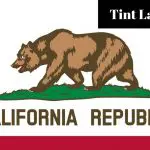If you’re a vehicle owner in Texas, you’re probably interested in applying some additional tint to your windows; it gets pretty hot and sunny in Texas, and you may find it necessary to tint your windows a little more to help make your daily commute more comfortable.
Of course, like every other state, Texas has its own unique set of regulations in place regarding how window tint can be applied to your car.
If you live in Texas, it’s worth familiarizing yourself with these regulations before tinting your windows; ideally, you want to apply your window tint correctly the first time, to avoid any legal consequences.
In this article, I’ll be going over everything you need to know about car window tint laws in Texas.
TABLE OF CONTENTS
Are You Allowed To Have A Tinted Windshield And Windows In Texas?
Prior to 2009, Texas didn’t have any laws regarding window tints. These days there are some restrictions in place as to how dark you can tint your various windows, although they’re fairly unrestrictive compared to window tint regulations in some other states.
The state of Texas allows you to install a tint strip on your windshield. This strip must have a minimum VLT of 25%; VLT is short for “visible light transmission” and it refers to the amount of light that is able to pass through your windows.
This strip cannot be wider than 5 inches, and it cannot go past the AS-1 line on your car’s windshield.
Your front side windows may also not be tinted with a VLT of less than 25%. However, there are no restrictions as to how dark you can tint your back side-windows and rear window in most cases.
What Is The Darkest Tint You Can Legally Get In TX?
This depends on the window that is being tinted. As I’ve mentioned, windshields and front side windows cannot be tinted darker than a VLT of less than 25%.
Your rear window can be tinted to any degree you want, as long as your car is equipped with dual side-mirrors. Since modern automobile regulations require dual side-mirrors to be installed on almost all cars made today, this shouldn’t be a problem for most individuals.
However, if you own an older car, it may only have one side-mirror; in this case, you cannot tint your window darker than a VLT of 25%.
Additionally, some modern cars feature rear-view cameras instead of side mirrors, and it’s unclear what the Texas DMV’s stance on these cars is in regards to cars like these.
Is 20% Tint Illegal In TX?
Once again, this depends on the specific window you want to apply tint to. For back side-windows and rear windows, a tint with a VLT of 20% or less is perfectly legal; but for windshields and front-side windows, you cannot use a tint that lets in less than 25% of sunlight.
While you may be tempted to go a little further over the legal limit and try to get away with using tint with a VLT of 20%, I would definitely not advise that you do this.
Aside from the legal factor, it can also potentially be unsafe; if you frequently drive at night, then a tint with a VLT of 20% or less might block too much light and leave you unable to see out of your windows.
Can You Get Pulled Over For Tinted Windows In Texas?
Having windows that are tinted too dark is absolutely an offense that you can be ticketed for.
It’s worth mentioning, however, that even if your windows are tinted illegally, you do not have to consent to a police search of your car, unless you have illegal items clearly visible in your car or the police have probable cause to search your vehicle.
Obviously, we’re not condoning the use of illegal tint or any other illegal behavior, but it’s important to be aware of your rights as a citizen when dealing with law enforcement.
How Much Is A Tint Ticket In TX?
The actual cost of a ticket for illegally tinted windows depends on a variety of factors. It can change depending on what county you live in, how much darker your tint is compared to the legal limit, and whether or not you have received similar tickets in the past.
As such, there’s a lot of variation in how expensive a tint ticket can be. If it’s only your first ticket for such an offense, it might be as low as $20-25.
If you choose to leave your window tint on even after getting a ticket, subsequent tickets can be much more expensive; a second ticket can potentially be as much as $275. Additional tickets might be more expensive still.
Your first ticket will generally be pretty lenient; you’ll no doubt be required to remove your tint as soon as possible and submit proof to your local law enforcement that you’ve done so, but usually that’s all there is to it.
However, if you get ticketed again for the same thing, you’ll probably have to appear in court and provide justification for why you left your tint on.
Regardless of what kind of ticket you’re likely to get, it will almost certainly be a hassle to deal with. Save yourself this hassle and make sure your windows are tinted legally in the first place.
Window Tint Darkness In Texas
We’ve already discussed in detail the existing regulations concerning tinting your windows, but in this section, we’ll be quickly summarizing everything we’ve gone over up to this point.
First, let’s clarify the differences between passenger vehicles and MPVs.
Passenger vehicles typically have space for 2-5 occupants, and don’t usually come with a specialized cargo area or too many extra features. Coupes, sedans, hatchbacks, station wagons, and convertibles all count as passenger vehicles.
MPVs (multi-purpose vehicles) often have third-row seating or an extra-large cargo area. MPVs generally have a more utilitarian function than passenger vehicles. Examples of MPVs include pickup trucks, SUVs, panel vans, minivans, RVs, and crossovers.
You can find out what type of vehicle your car is classified as by checking the Federal ID label. You can find this label on your driver’s side door frame in most cases.
For Passenger Vehicles
- Windshields can have a tinted strip with a VLT of 25%. This strip must be no wider than 5 inches and must not go beyond the AS-1 line on your windshield
- Front side-windows are restricted to a VLT of 25%
- Back side-windows have no tinting restrictions
- Rear windows have no tinting restrictions unless you lack dual side-mirrors, in which case they are restricted to a VLT of 25%
For MPVs
- Windshields can have a tinted strip with a VLT of 25%. This strip must be no wider than 5 inches and must not go beyond the AS-1 line on your windshield
- Front side-windows are restricted to a VLT of 25%
- Back side-windows have no tinting restrictions
- Rear windows have no tinting restrictions unless you lack dual side-mirrors, in which case they are restricted to a VLT of 25%
Window Tint Reflection In Texas
The state of Texas also has laws in place regulating how reflective car windows can be. This is intended to be a safety measure, since an overly reflective windshield can be blinding for oncoming drivers.
Current regulations state that all windows on a car can’t reflect more than 25% of the sunlight that hits them.
In addition, any colored tints are illegal to apply to your windshield.
For Passenger Vehicles
- Windshields cannot reflect more than 25% of sunlight
- Front side-windows cannot reflect more than 25% of sunlight
- Back side-windows cannot reflect more than 25% of sunlight
- Rear windows cannot reflect more than 25% of sunlight
For MPVs
- Windshields cannot reflect more than 25% of sunlight
- Front side-windows cannot reflect more than 25% of sunlight
- Back side-windows cannot reflect more than 25% of sunlight
- Rear windows cannot reflect more than 25% of sunlight
How Do You Get A Medical Exemption For Window Tint In Texas?
To get a medical exemption for your window tint in Texas, you obviously need to have a medical condition that is exacerbated by sunlight.
If you want to apply for such an exemption, you’ll first need to acquire a signed statement from any licensed physician. Then you’ll need to get in touch with the Texas Department of Public Safety in order to actually get the exemption.
If you manage to get a medical exemption, you’re allowed to have a VLT of under 25% for your front side-windows. However, this exemption does not apply to your windshield.
There are many medical conditions you can have which may require you to seek a medical exemption for window tint; some examples of these include lupus, solar urticaria, and albinism.
Conclusion
There are a few things you have to remember when tinting your car windows as a Texas resident, but luckily there’s nothing too complicated to remember and most of the regulations currently in place are pretty unrestrictive as it is.
I hope that I’ve made the various rules and regulations concerning window tint laws in the state of Texas easy to understand.
If you require any further information on the subject, you should check out the website for the Texas DMV; everything you need to know about complying with Texas vehicle regulations can be found there.




